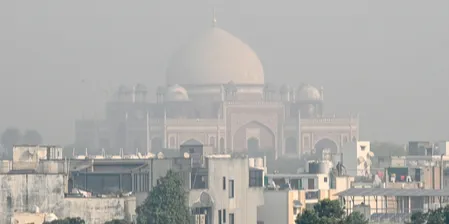Delhi's air quality drops to alarming levels, as city faces severe pollution crisis
Toxic air

Poor visibility in Delhi this morning.
Image: IANS
IF YOU are planning on travelling to Delhi, here is something to keep in mind. The city woke up to yet another day of toxic air today, recording an Air Quality Index (AQI) of 385, firmly in the “very poor” category.
Air pollution across Delhi-NCR continues to remain hazardous, offering little respite to residents already struggling with a cold wave.
The spike in pollution comes barely a day after authorities lifted the Graded Response Action Plan (GRAP) Stage-III restrictions, which are enforced to curb severe pollution levels. However, the relief was short-lived, as the air quality deteriorated rapidly once again. Yesterday the city’s overall AQI rose sharply to 377, up from 327 the previous day, marking a significant decline in air quality within 24 hours.
Despite the worsening conditions, the Commission for Air Quality Management (CAQM) has clarified that the Stage-III curbs would only be reinstated if the AQI crossed 400, which falls under the “severe” category. Until then, authorities plan to continue monitoring the situation without re-imposing stricter curbs.
According to the Central Pollution Control Board (CPCB), pollution levels surged steadily throughout the day on Thursday due to persistently low wind speeds. The AQI, recorded at 351 at 8am, escalated to 381 by 7pm, indicating continuous accumulation of pollutants over the region.
Meteorologists suggest that the winds remained almost stagnant for most of the day, with only brief movements at 4 to 5 kmph, insufficient to disperse particulate matter. Forecasts suggest the national capital is likely to stay in the “very poor” category over the next few days.
Meanwhile, the ongoing cold wave gripping Delhi and nearby cities is compounding the crisis. The combination of low temperatures, fog, and high pollution levels is worsening public health conditions.
In Delhi-NCR and several cities across North India, temperatures have dropped to minimum levels of 8 to 12 degrees Celsius.
A thick layer of haze blanketed the city from morning hours and returned in the evening, significantly reducing visibility on roads and contributing to slower traffic movement.
Health experts warn that breathing in such polluted air can have severe consequences, especially for children, the elderly, and individuals with respiratory or cardiac conditions. They advise residents to stay indoors as much as possible, avoid strenuous outdoor activities, and step out only when necessary. - IANS
Related Topics: